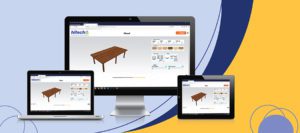
Ketan Panchal
Online visual product configurators offer greater choice and control to the consumer over product features, while integrating seamlessly with software from point of sales to cutting rooms. They make true end-to-end design automation possible for the product manufacturer while making it immensely easy for the customer to visualize all available options in color, material, and features.
Because of the wave of COVID-19, business-to-consumer, business-to-consumer, and manufacturer direct-to-consumer online buying trends have increased for engineer-to-order (ETO) and configure to order (CTO) manufacturing of building components, metal fabrication, and furniture manufacturing. The market now demands granular personalization.
Consequently, product manufacturing firms are struggling to balance the requirements of personalization, quality, and timely delivery. Under such circumstances, visual configurators provide them with the edge they need to deliver product customization, offer a better digital customer experience, and increase sales.
(Gartner predicts that by 2021, early adopter brands that redesign their websites to support visual and voice search will increase digital commerce revenue by 30%.)
While the pressures for mass customization fall upon everyone along the production chain, from sales to shop floor, product designers have to bear the brunt. Product designers not only have to ensure fast delivery of customizations, but they also need to ensure delivery of proper technical documents to other organization verticals like sales, marketing, quality, purchase, and shop floor.
To accelerate design cycles, product designers are fast adopting the latest tools in 3D computer-aided design (CAD) that offer 3D product viewing and custom configuration.
Moreover, 3D visual product configuration holds the key to turning manufacturing systems more productive and competitive. 3D configuration tools like DriveWorks and Tacton allow the whole product manufacturing value chain, including designers, sales and marketing teams, shop floor, and customers to communicate requirements, design concepts, and final quality products seamlessly.
Challenges in developing new customized designs
To deliver a high level of personalized designs, manufacturers must:
- Deliver accurate quotes in real time, so that customer product specifications are met, and margins properly accounted for;
- Provide accurate documents to avoid any delay in redesign and rework across the value chain;
- Manufacture the products at shop floor with a minimum possible loss in lead time or quality, or gain on both counts.
Product design lies at the core of the manufacturing value chain, and the product designer faces challenges and issues from all angles and needs to:
- Quickly understand requirements, generate concepts and designs that meet the customization with available product mix, inventory, and shop floor production capacity;
- Ensure speedy delivery of all technical documents and drawings for sales, purchase, quality, and manufacturing to make and deliver the product the first time right;
- Closely supervise and monitor product development while collaborating with functional teams of sales, manufacturing, vendors, and quality.
Inevitably, to meet the deadlines for time to market, designers need to be more efficient and productive. Barebones use of 3D CAD tools and macros cannot cope with accelerated delivery of customized demands. But with the use of 3D visual configurators, they can tackle these issues.
How visual configurators benefit the designer and manufacturer
With the ability to configure, price, and quote (CPQ) in real-time, 3D visual product configurators change the game for product design engineers and ETO, CTO manufacturers.

Manufacturer’s benefits from visual configurators (for improved customer experience and efficient sales) include:
- Allowing a customer to configure a product using mix-and-match from available options, thus providing greater customization control at the point of sales;
- 360-degree view of products in a realistic environment;
- Providing required product catalogue drawings, images, and use of native 3D CAD files to enhance the product buying decision;
- Real-time design customization allows capturing the need of customers with improved interactions and accurate understanding;
- Quick generation of quotes and closure of deals in a single meeting.
Benefits to the designer (for quick and accurate customized design and documentation) include:
- Allowing simple to complex product offerings from ETO to CTO form;
- Making designs easy to access,Putting all product offering designs on a single 3D visual and common engineering data-based platform with integration on business and CAD platforms;
- Eliminating repetitive error-prone design tasks of design iteration and generating technical documents;
- Designers are able to deliver accurate designs and documents;
- Accelerating the designs from weeks to days;
- Fast generation of error-free technical documents for sales, purchase, quality, and shop floor;
- Improved seamless collaboration among teams across the value chain;
- Improved productivity of the designer;
- Improved quality and customer satisfaction.
How does it work?
3D visual configurators are highly flexible and can turn any kind of product mix customization into configurable options.
User-friendly, interactive, and predictive 3D visual interface
3D visual configurators create an interactive GUI so that customers can make buying decisions quickly. Customers can experience the product on any platform of ecommerce with a high degree of personalization.
The configurators also include pricing rules for instant sales. Manufacturers can include rules to maintain their bottom line and profit margin for each possible product customization. At an advanced level, a 3D configurator can also predict delivery dates based on order quantity, running production, level of inventory, and logistics.
Ready to use design templates and ease of programming
Most 3D visual configurators provide ease of programming with ready-to-use templates so that a designer can embed design rules of many possible combinations for product configuration and select product mix. It permits designers to make configurable 3D CAD-based designs for most product offerings based on predefined engineering rules and product mix. A 3D visual configurator uses centralized design data with the techniques of master modeling and creation of part families that reduces the efforts of product designers by almost 100% in repeat designs of product mix. It also enhances the accuracy of designs and product manufacturing.
Seamless integration with systems in use on a common platform
A 3D visual configurator integrates with most CAD systems like SolidWorks, Creo, Autocad, Inventor, etc., and business databases like ERP, CRM, and MES. New configurator tools allow interoperability with legacy systems still in use in manufacturing organizations. It offers flexibility and a high degree of adaptability among users. It also integrates with cloud-based technology, allowing users to use the same from anywhere anytime.
High degree of automation for communication and collaboration
Due to the use of a common platform and access to common databases of products, related design, cost, inventory, and manufacturing, a 3D visual configurator provides efficient product part search abilities, reusability, and modifications to accelerate new products innovation and offerings. New product design efforts are drastically reduced by almost 40% to 60%. It auto-generates accurate quotes, high-detail renders of 3D product images, and catalog drawings for marketing, BOM, shop drawings and DXFs for manufacturing. The rule-based workflow allows highly collaborative and real-time environments for design reviews and decision making.
Commerce, whether B2B, B2C, or DTC, has made a permanent shift to online markets and transactions. Even in products where transactions take place in-person and in showrooms or brick-and-mortar premises, product research and thus product presence has essentially gone online.
With the increased use of augmented reality and predictive AI analytics, 3D visual configurators have become indispensable for product designers and manufacturers.
Ketan Panchal is a design manager at Hitech CADD Services, a provider of computer-aided design services.
Favorite